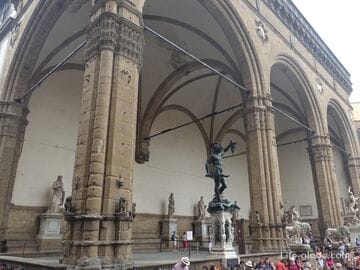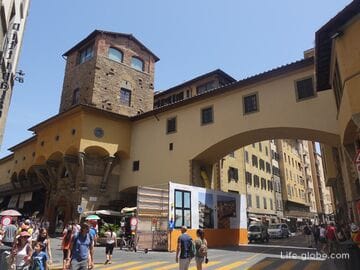Opera Duomo Museum / The Opera del Duomo or simply the Duomo Museum (Museo dell'Opera del Duomo di Firenze) is a museum of the Cathedral complex of Florence Santa Maria del Fiore (La Cattedrale di Santa Maria del Fiore), containing many original works of art and masterpieces created for the interiors and exteriors of the cathedral itself (Duomo), and for the bell tower of Giotto (Campanile di Giotto) and the Baptistery of San Giovanni (Battistero di San Giovanni) in Florence.
The museum is located in a historic building to the east of the Duomo, near its apse. The museum was opened on May 3, 1891.
Above the vaulted historical entrance of the museum there is a bust of Duke Cosimo I de' Medici, by Giovanni Bandini.
This entrance led to the offices and laboratories of the Opera del Duomo. Since the fifteenth century, the premises that are now used as a museum were used for various stages of planning and preparation of the works of Santa Maria del Fiore: Filippo Brunelleschi had his headquarters here, and Michelangelo sculpted David, originally intended for the buttress of the dome of the cathedral. From the seventeenth to the nineteenth century, these premises also served the Opera as warehouses, and from 1891 to the present day they are a museum.
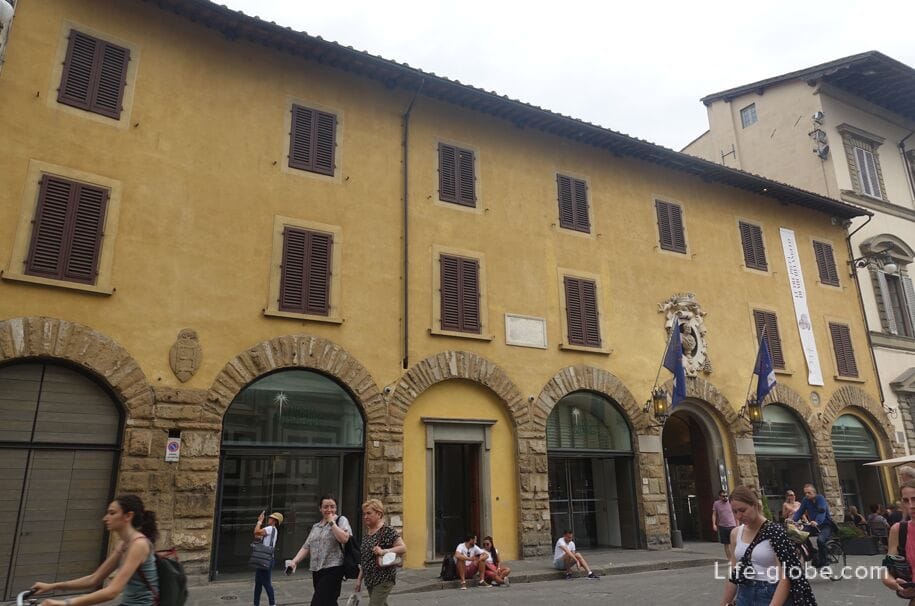
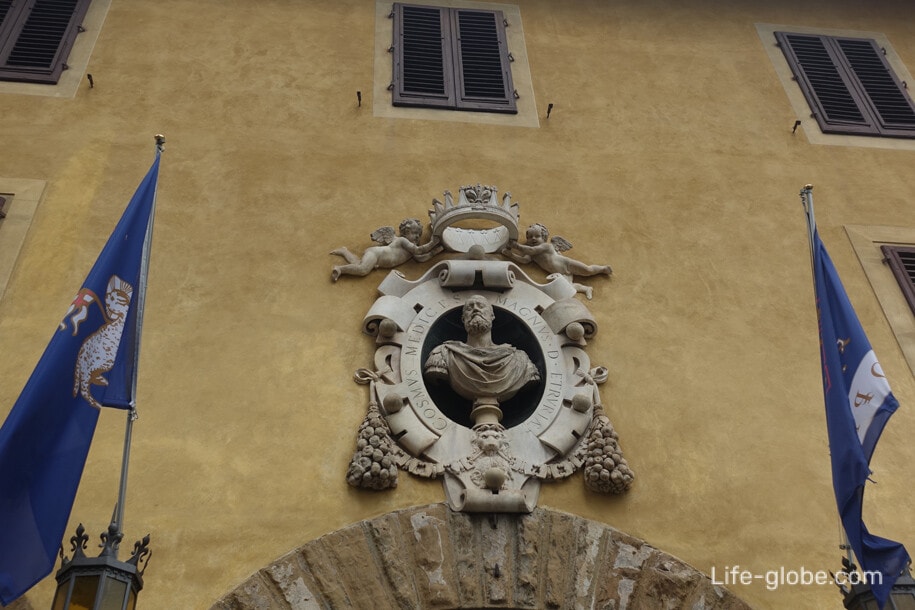
The museum is one of the most important museums in the world, both in value and in the number of works of art stored inside.
The museum's exposition, located in many halls on several floors, has more than 750 works and is the cradle of the Renaissance. Now the museum houses what is called "one of the most important collections of sculpture in the world."
Authentic masterpieces of art are kept here, which for more than seven centuries have decorated the monuments of the Duomo complex: from the works of Michelangelo, to Donatello, Brunelleschi, Ghiberti, Bandinelli, Sansolino and others.
From the exhibits: parts of the former decoration, tombstone inscriptions and architectural elements; sculptures, sculptural groups, paintings, bas-reliefs, doors, shrines, crosses, church clothes and utensils; other objects and decorations related to the history of the Florence Cathedral complex, as well as models of the cathedral and the dome of the Brunelleschi Cathedral.
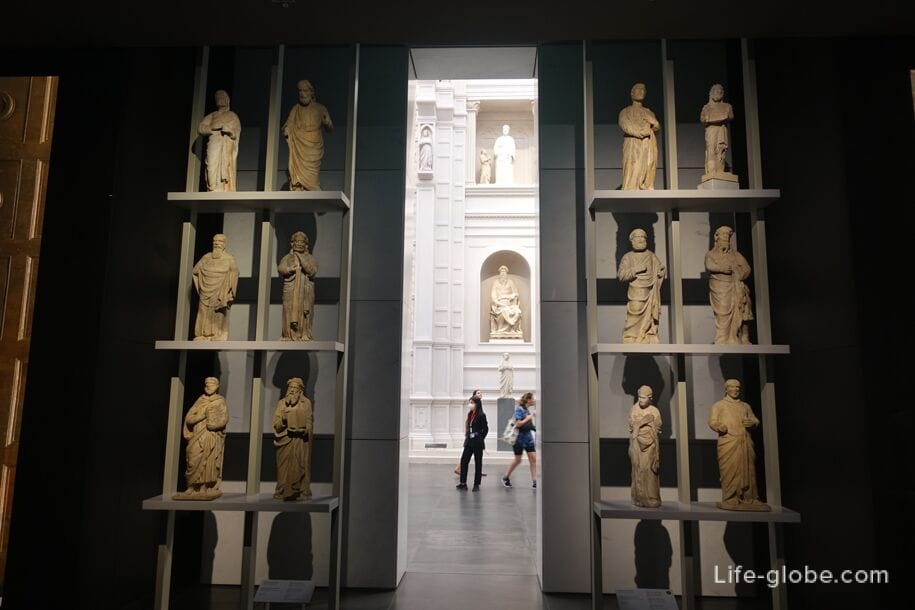


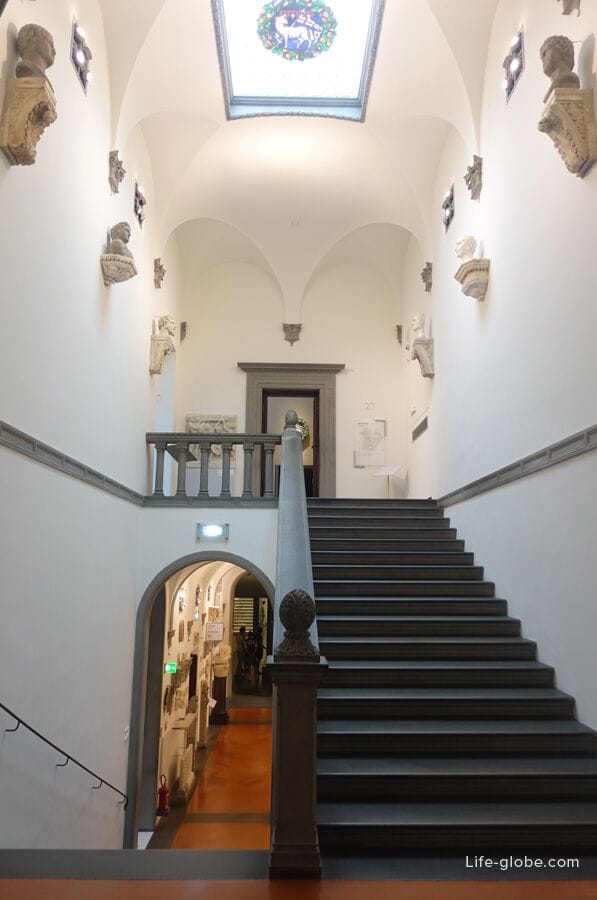
Halls and exhibits of the Duomo Museum
At the entrance to the museum, guests are greeted by the former, now covered courtyard of Ticciati, which is decorated with a recreated theatrical sculpture group of the Baroque altar of the baptistery, St. John in Glory with angels-candlesticks by Girolamo Ticciati in 1732. The sculptural group decorated the baptistery until 1912; after that, the medieval altar was restored in the baptistery.

Sculpture gallery, which presents works from the baptistery and the sides of the cathedral, as well as the rear frames of the bronze doors of the baptistery. On the right side is a wooden model of a medieval facade and a film telling about the history of the facade's construction.
Together with the works of Tino di Camaino for the baptistery, this gallery contains important fragments of the richest side doors of the Duomo, the northeastern one, known as the Porta della Mandorla, built between 1391 and 1422 by several sculptors, including the young Donatello.
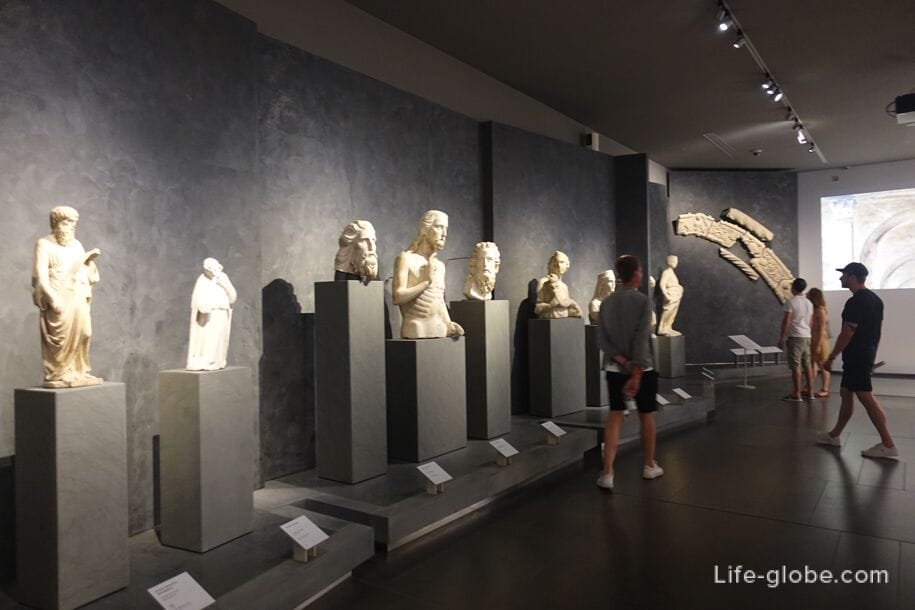

The Hall of Paradise, where the original doors of the baptistery are located, which Michelangelo called the "Gates of Paradise". The doors have ten large squares, five in one vertical row on each leaf. The reliefs show scenes from the Old Testament, which follow one another from left to right and from top to bottom. The frames are decorated with images of the prophets; at the bottom, the sculptor placed his portrait and his son Vittorio. The bronze of the doors is gilded and sparkles brightly in the sun. Above the gate there is a group of statues depicting the Baptism of Christ by Andrea Sansovino.
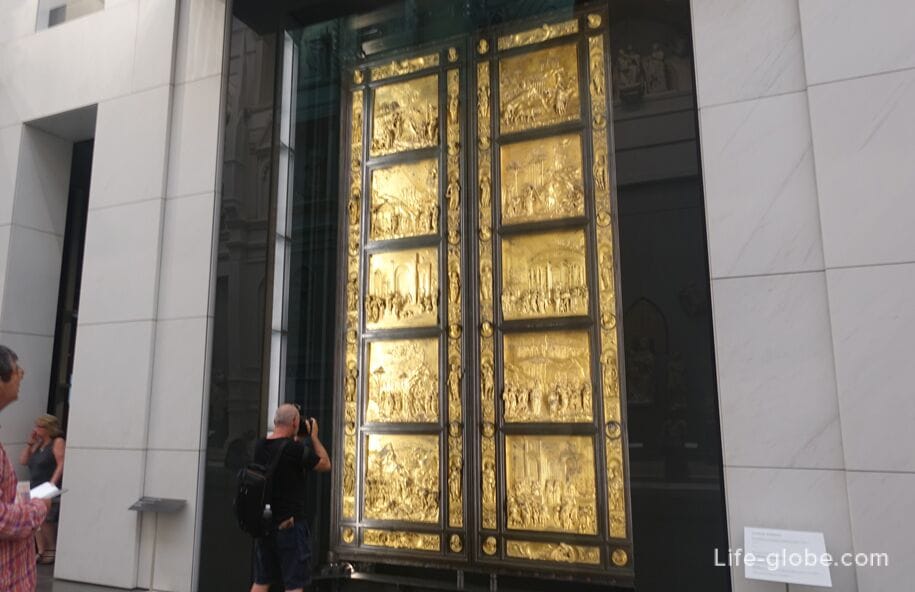
Also in the hall of Paradise you can see the oldest - the southern doors of the baptistery, created between 1330 and 1336 by the sculptor Andrea Pisano. The doors depict episodes from the life of the Baptist in the top twenty sections and Christian virtues in the remaining eight.
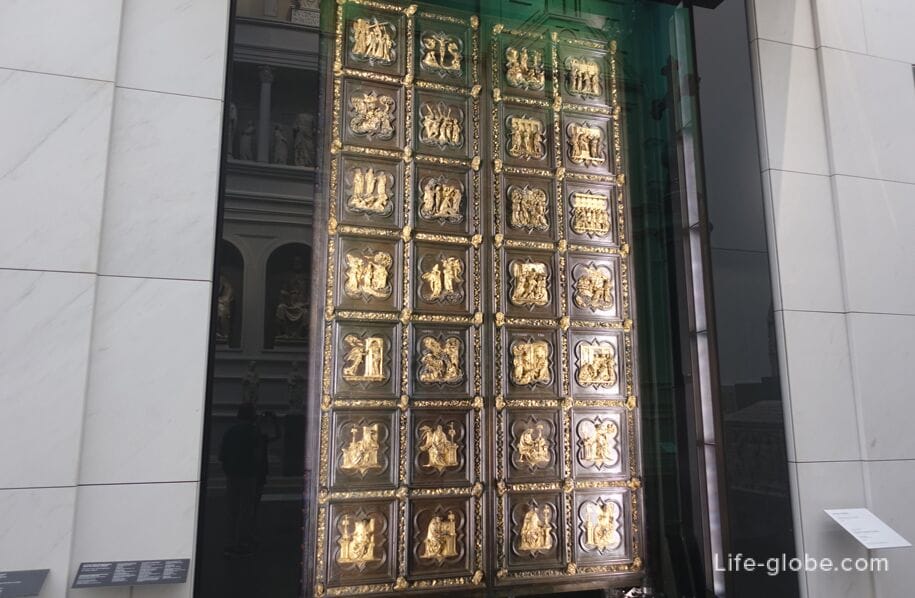
In addition, in the hall of Paradise there are sculptures and sculptural groups for the exterior of the cathedral and baptistery, as well as sarcophagi from the Duomo Square.
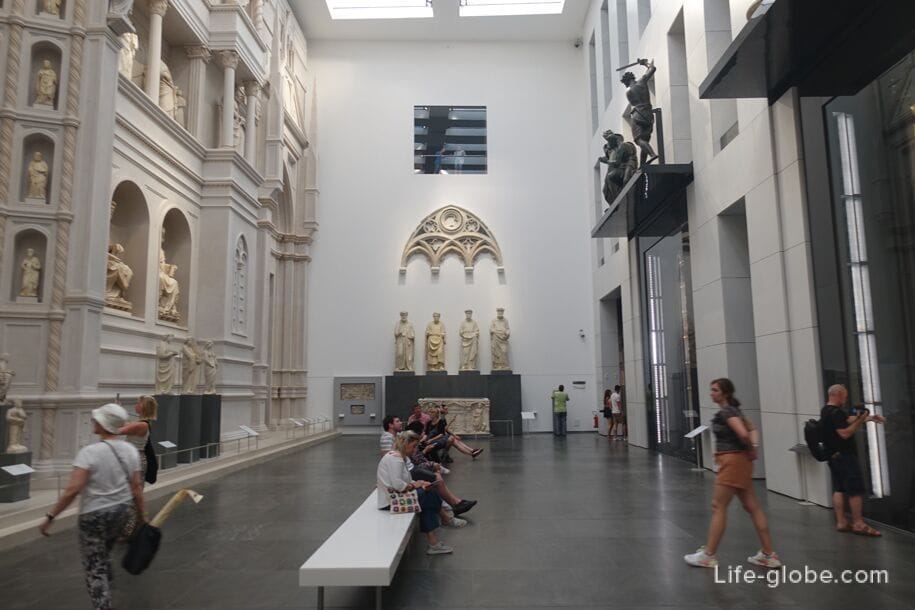
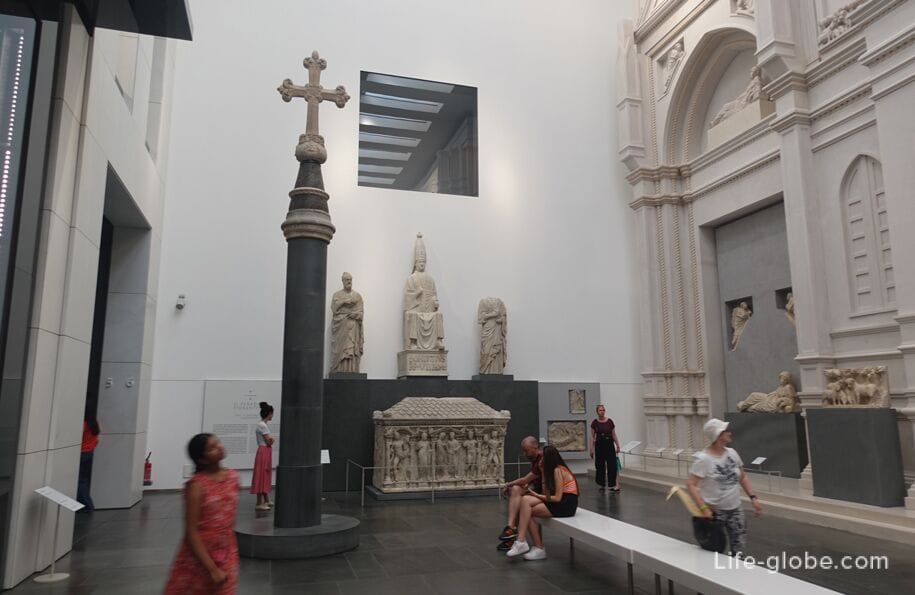

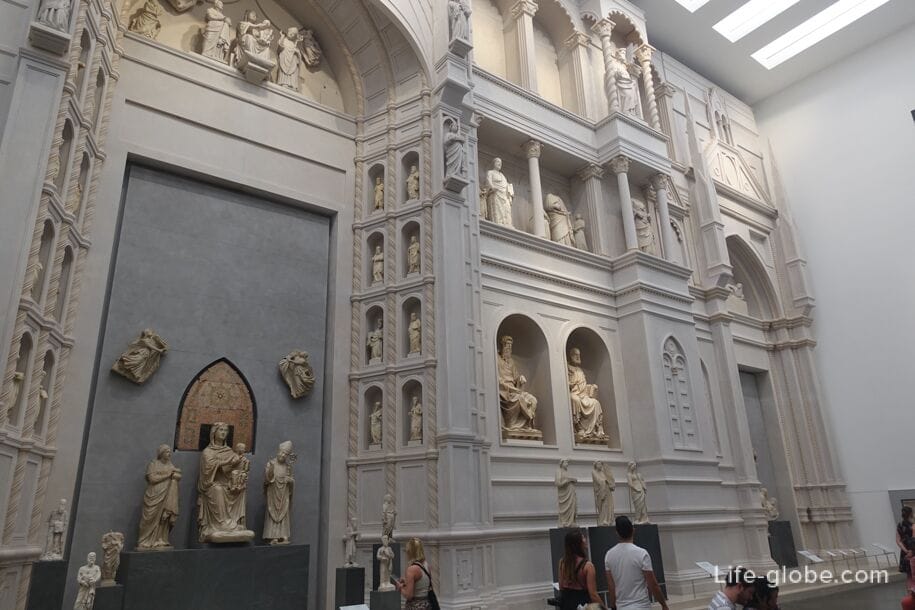
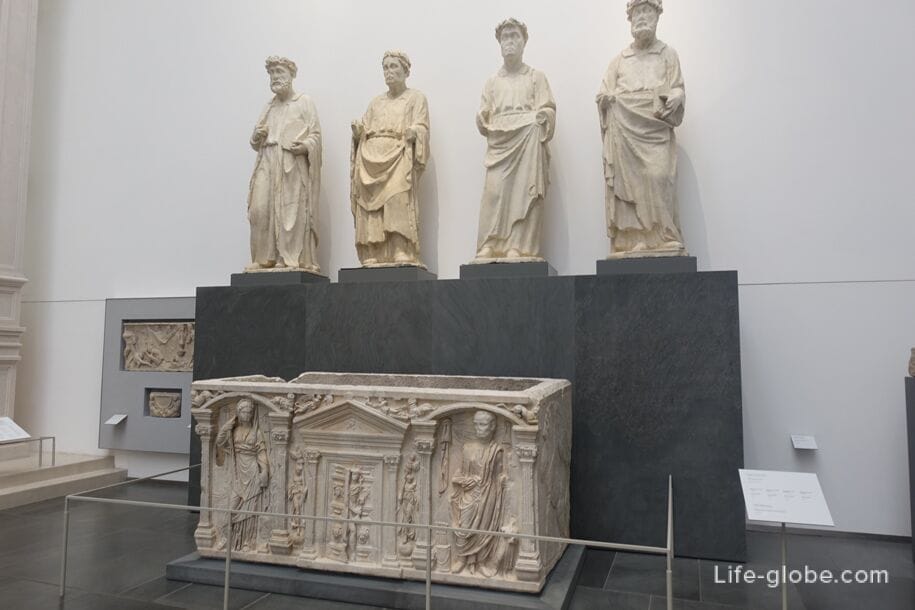
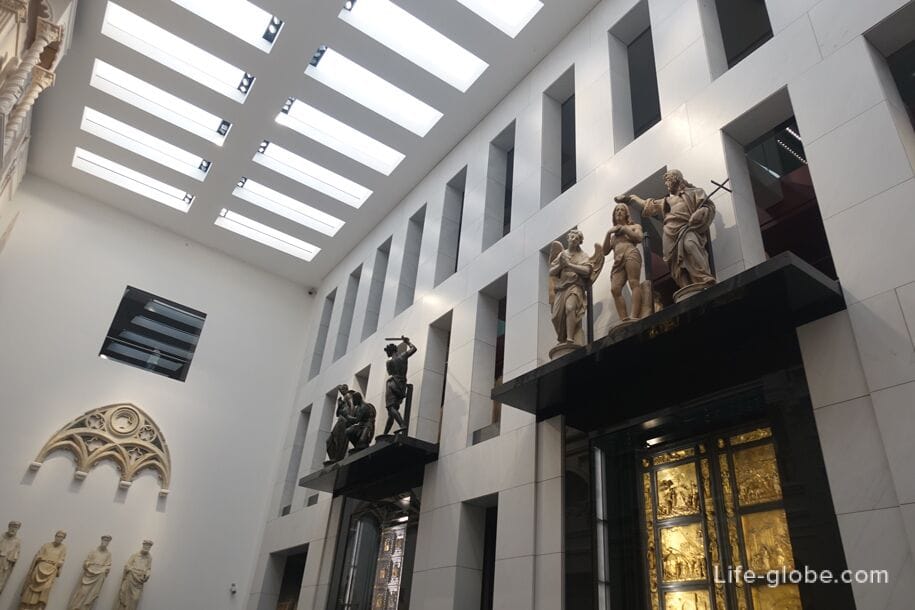
The Magdalene Room, where the penitent Saint Mary Magdalene by Donatello and paintings and sculptures depicting saints are collected, in which the patrons sometimes appear in a pose of prayer.
The work from which the first room takes its name is a wooden statue created by Donatello in the mid-1450s depicting a woman mentioned several times in the New Testament: Mary Magdalene, whom Jesus freed from seven demons (Lk. 8,2) and this popular piety was mixed with a sinful woman forgiven by Christ for that she loved a lot (Luke 7:47). Donatello weaves the various threads of the narrative into a single image, representing Magdalene penitent, with a disfigured fasting and vigil body and face, but praying and at rest. There is also a painted terracotta bust showing her still young and attractive, and a glazed terracotta relief depicting her praying in the desert. The statue of Donatellian was probably made for the baptistery, where it was located from the end of the fifteenth century until 1966. A marble plaque placed in the eighteenth century under the figure testifies to Florence's never-diminishing devotion to this saint.
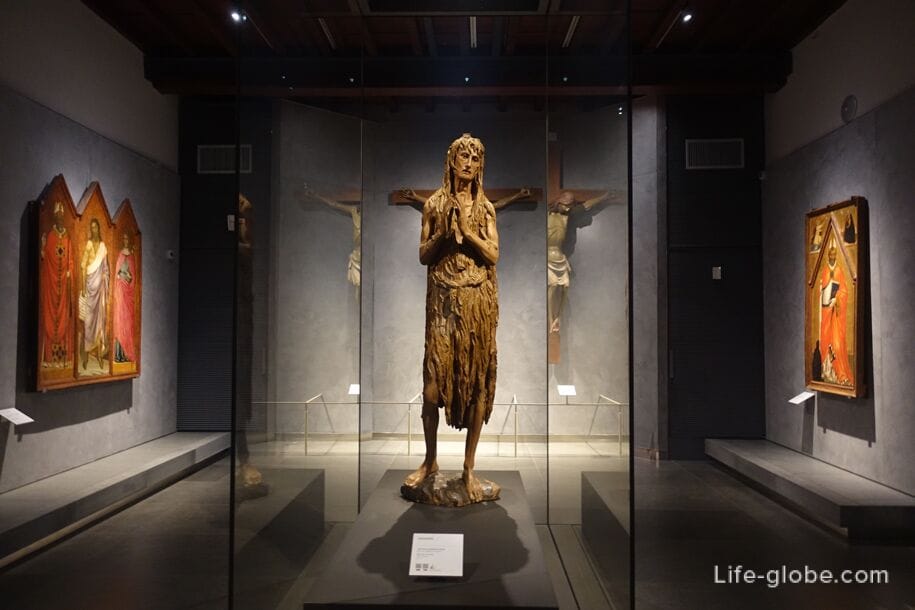
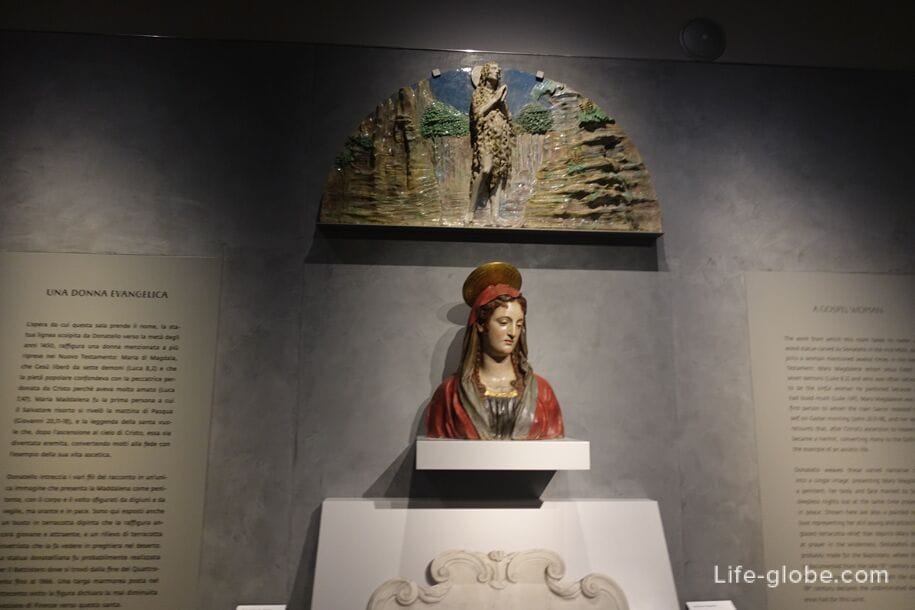
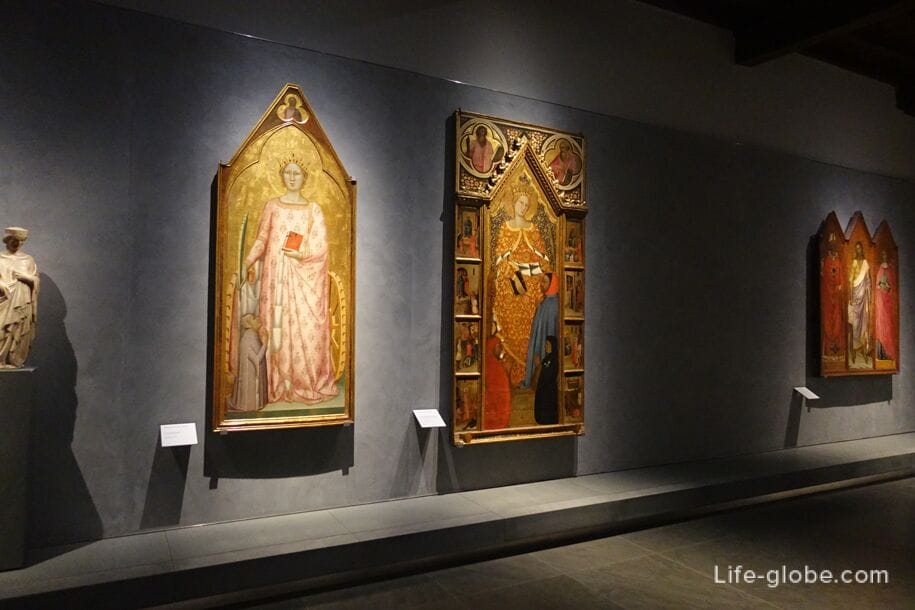
The Chapel of Relics, where some of the reliquaries kept in the cathedral and in the baptistery are presented.

Michelangelo's tribune, where the "Pieta" ("Position in the Coffin") is located, is the penultimate sculptural work of Michelangelo, who, according to modern sources, conceived it for the altar of the Roman church, at the foot of which, as he thought, he would be buried.
Begun around 1547-1549, the work was abandoned at the end of 1555 when Michelangelo mutilated it; the destructive act occurred due to the disappointment of an elderly master who discovered defects in the marble. Reassembled, the Pieta was bought in 1671 by Cosimo III de' Medici, Grand Duke of Tuscany, and placed in the basement of the Basilica of San Lorenzo; in 1722 it was moved to the cathedral and placed in front of the altar of the Most Holy Theotokos.
The Pieta group depicts the body of Christ taken from the cross. The body is supported by Mary Magdalene, the Mother of God and Nicodemus (or Joseph of Arimathea), in whose image the master depicted himself.
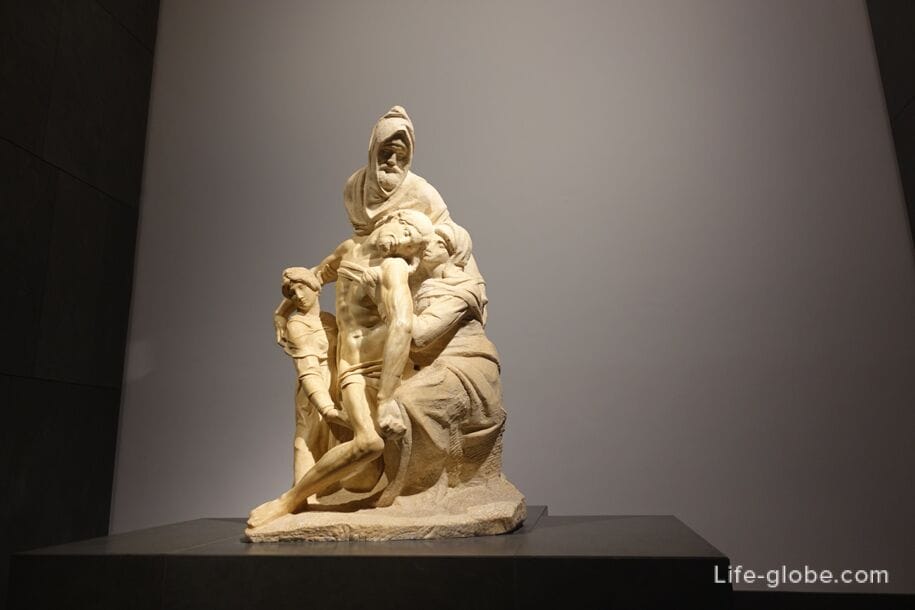
The Campanile Gallery with sixteen monumental statues and fifty-four reliefs, of which the first and most substantial core was created starting in 1334 by Andrea Pisano with various assistants, including his son Nino. The themes are God-inspired prophecies evoked by figures in the Land of Israel and pagan Sibyls, and human creativity illustrated in reliefs depicting biblical inventors of agriculture, cattle breeding, art and professions. Other reliefs show astrological influences, theological and cardinal virtues, and the seven sacraments of the Church.
On the other side of the gallery, the order of the statues, already changed in 1464, repeats the grouping of the individual sides of the bell tower, but rejects them to place the famous figures of the fifteenth century in the center of the gallery.
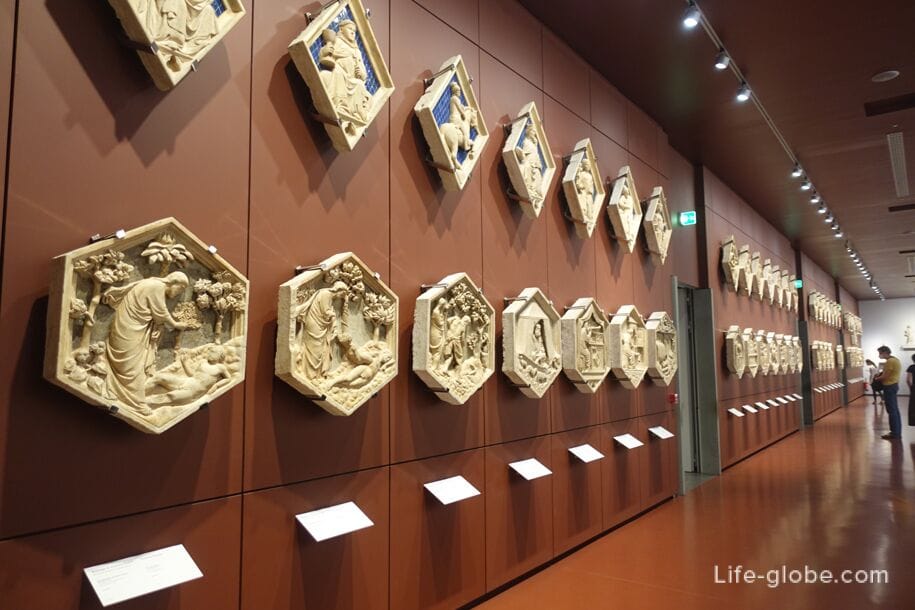
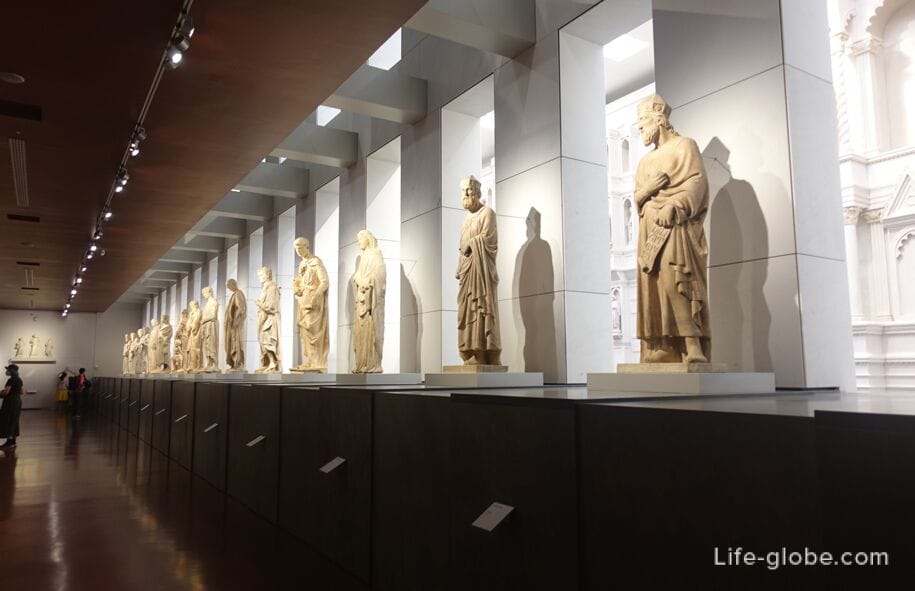
The dome gallery dedicated to the famous dome of the cathedral, built according to the plans of Filippo Brunelleschi.
Today, the dome of the cathedral can be climbed; there is an open 360-degree observation deck. More about the Brunelleschi Dome and the observation deck…
In this room there is a funeral mask of Filippo Brunelleschi, wooden models of the dome and lantern of the fifteenth century and a selection of antique instruments. The gallery also houses large modern models and an area where a short explanatory film is shown. There are also models of the late fifteenth and early sixteenth centuries relating to the lining of the drum, which remained unfinished after Brunelleschi's death in 1446.
Other models and didactic projections resemble the projects that arose as a result of the completion of the dome: the choir, built under it by Brunelleschi in 1436; stained glass windows created since 1436 by Ghiberti, Donatello, Paolo Uccello and Andrea del Castagno; a monumental cornice experimentally installed on the southeastern side of the vestibule by Baccio d'Agnolo in 1515.


The hall of the naves, which contains some paintings that were once placed in the aisles of the cathedral, together with the remains of the first of the monuments to outstanding people that Santa Maria del Fiore is famous for: the tomb of the leader Piero Farnese (1310-1363), obtained from an ancient Roman sarcophagus and originally crowned with an equestrian statue, the shape of which resembles the outlines of the eighteenth century. and the nineteenth century. Among other relics of the veneration of Mary, there is the famous sculptural group of the Annunciation, created in the early 15th century for the exterior of the side door of the Duomo, but then installed for several years inside, above the altar.

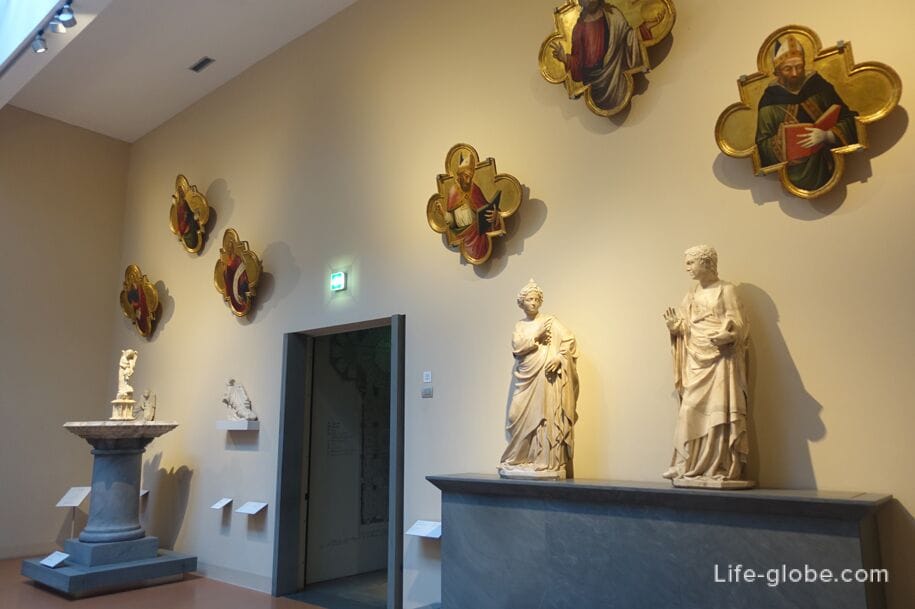
The Cantoria Hall, which resembles the presbytery of Santa Maria del Fiore, a place where "presbyters", that is, priests, and other clergy gather.
Here, along with furniture and religious objects, there are choirs by Luca della Robbia and Donatello, once located on the northeast and southeast columns of the Duomo, above the main altar. These galleries for singers and organs were completed in the early thirties of the fifteenth century. In both choirs, the image of children testifies to the joy of the Florentines from the completion of the cathedral begun in 1296.
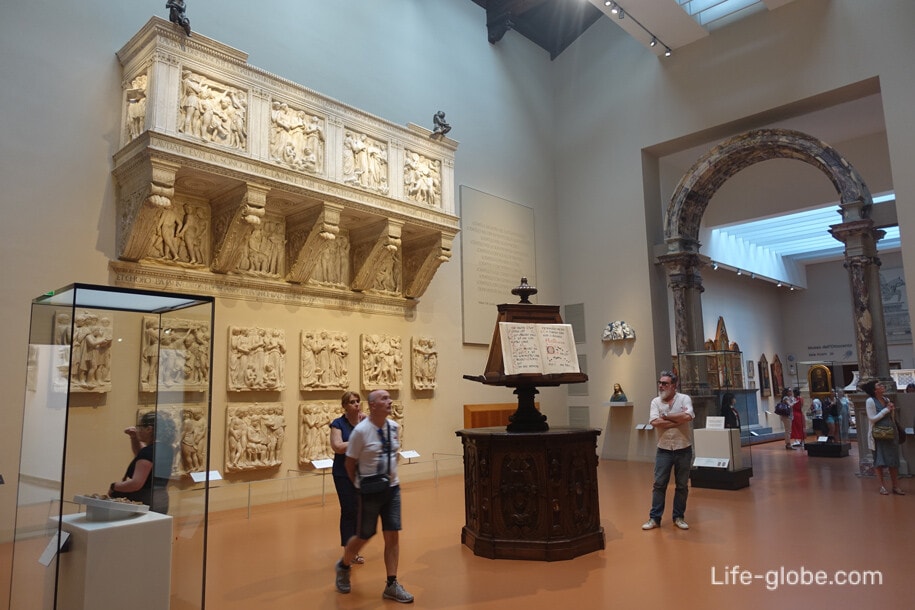
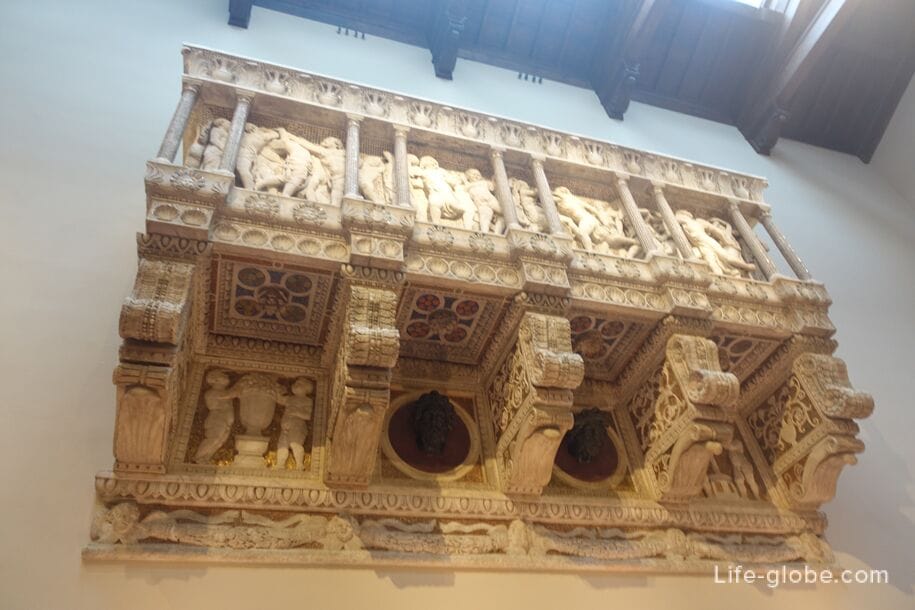
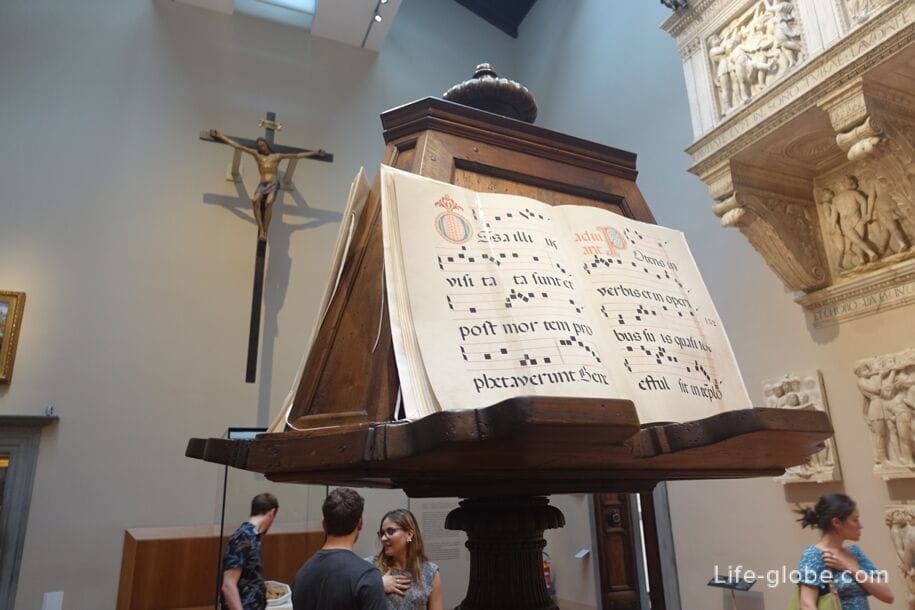
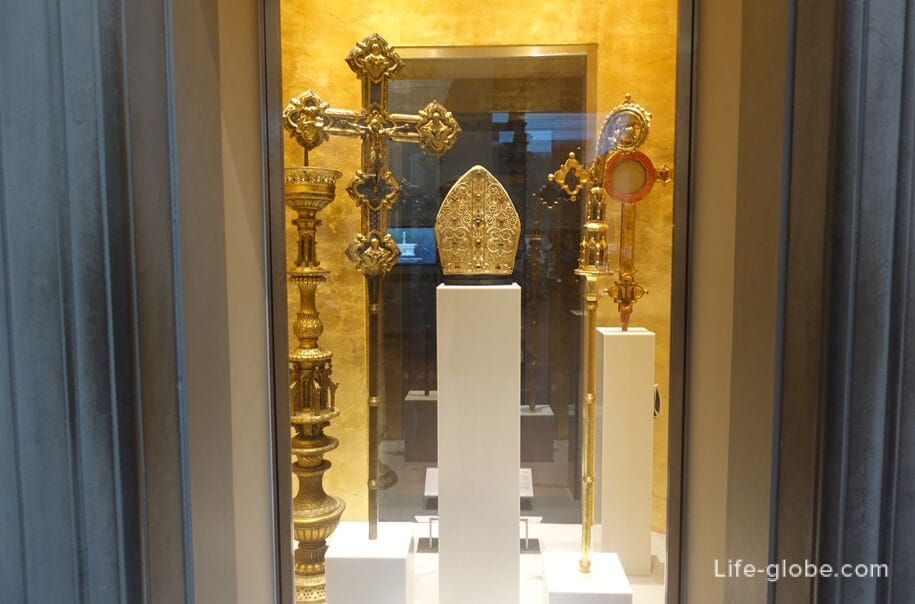
The Hall of the Bandinellian Choir, where elements of the new marble enclosure of the presbytery or "choir" of the Duomo, commissioned by Cosimo I de' Medici Baccio Bandinelli in 1547 and completed in 1572, have been preserved: the first of a series of interventions aimed at modernizing Santa Maria del Fiore.
The 1:25 scale model attests to the original richness of the Bandinellian structure, simplified in the nineteenth century, and the floor plan resembles Bandinelli's reuse of the octagon shape that Filippo Brunelleschi had already given to the choir in 1436.
In the showcases above the bas-reliefs are liturgical vestments of the sixteenth, seventeenth and eighteenth centuries.
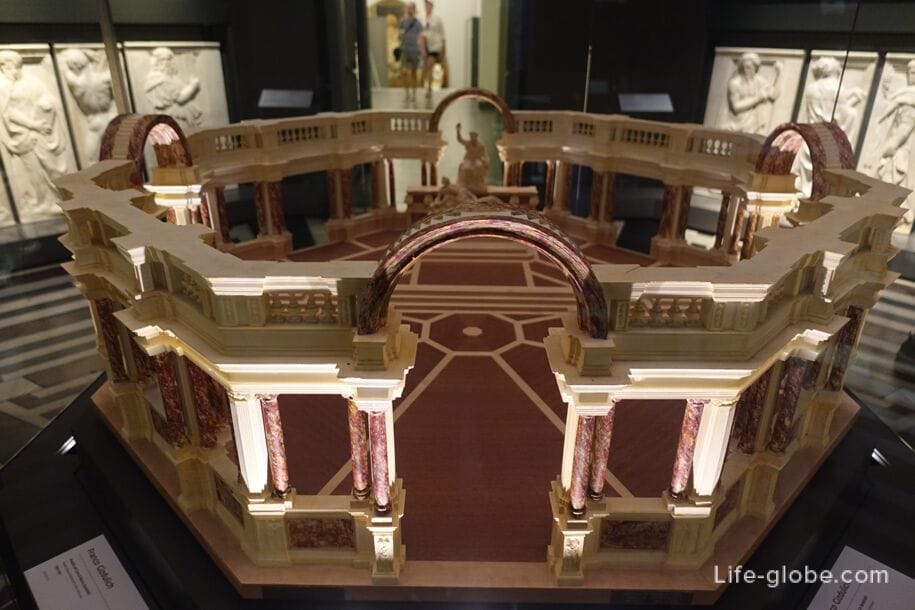
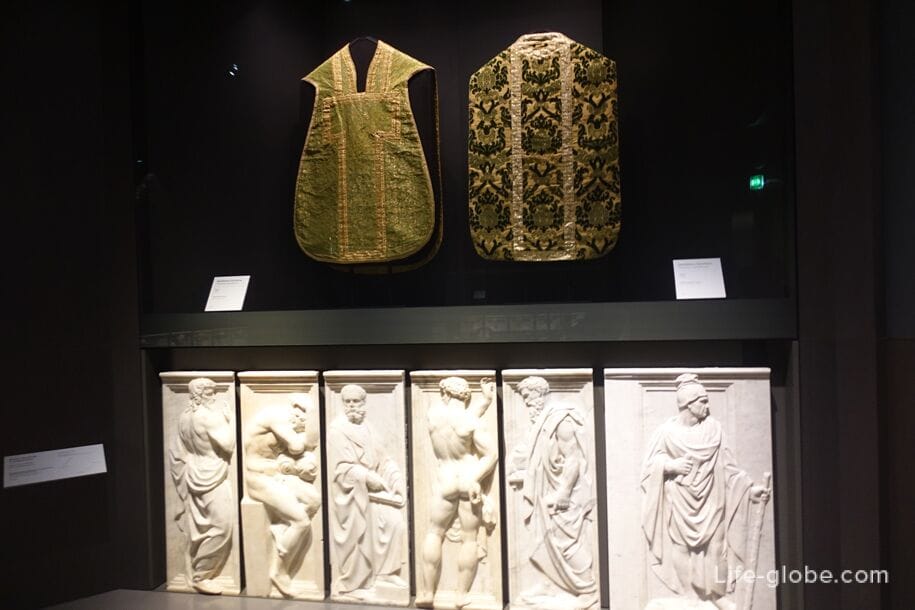
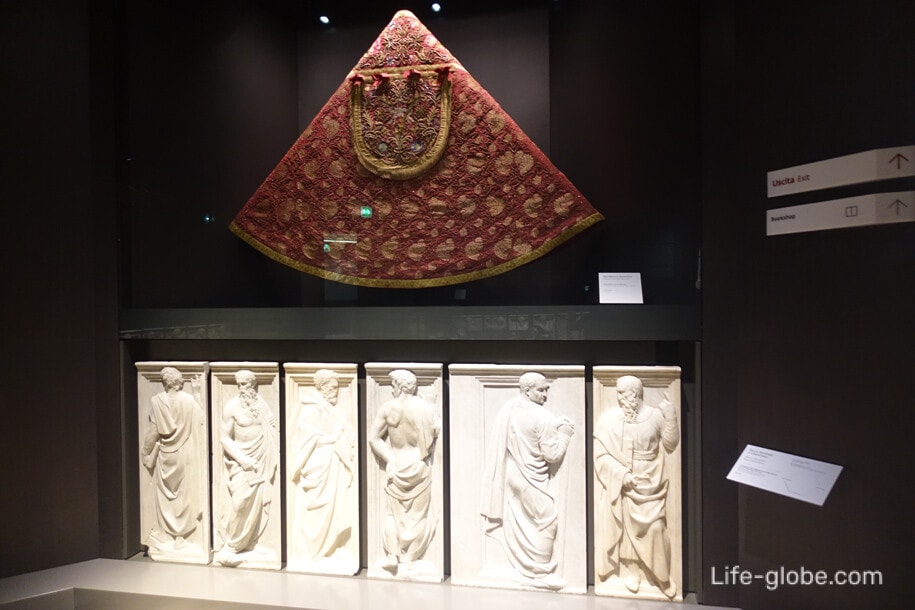

The Treasure Hall or "Treasury", where there is a silver altar facade and a monumental cross made of the same material with a total weight of almost 250 kg. only in metal parts. They were created by several generations of artists, starting in 1367. These intricate assemblies of thousands of components were at the center of the greatest religious holiday of the Florentine Republic, the feast of the patron Saint John the Baptist on June 24, when they were installed in the church dedicated to him, the Baptistery.
This room also preserves the remaining embroidery of the Parato di San Giovanni: twenty-seven historical panels designed by Antonio del Pollaiolo, originally located on two dalmatians, on a planet and on a white brocade robe used for the feast of the patron saint. These embroideries are primarily of artistic value.
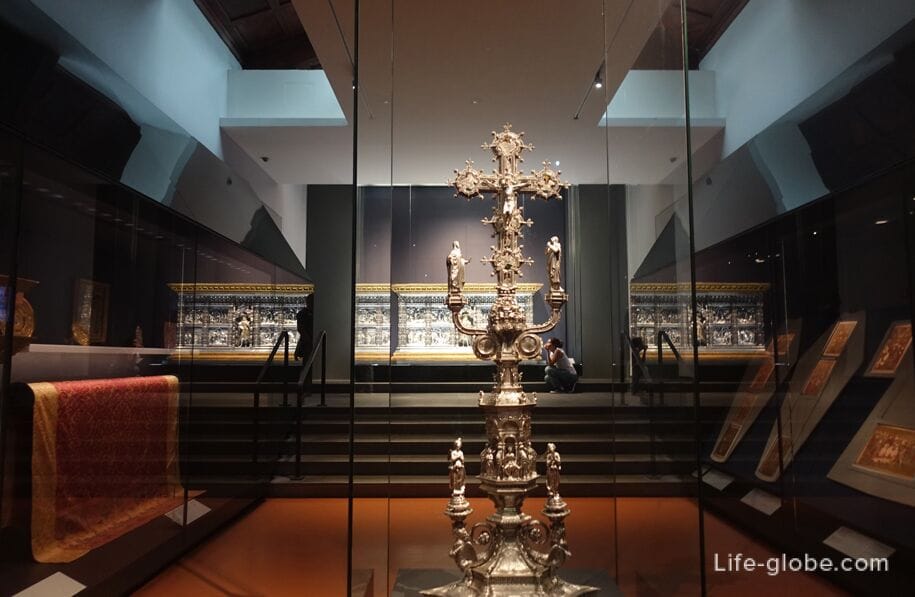
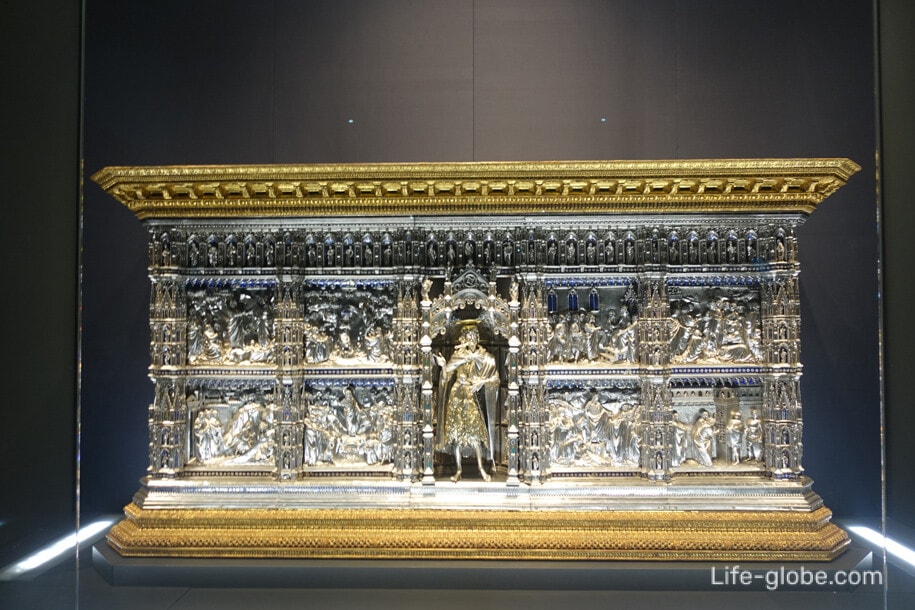
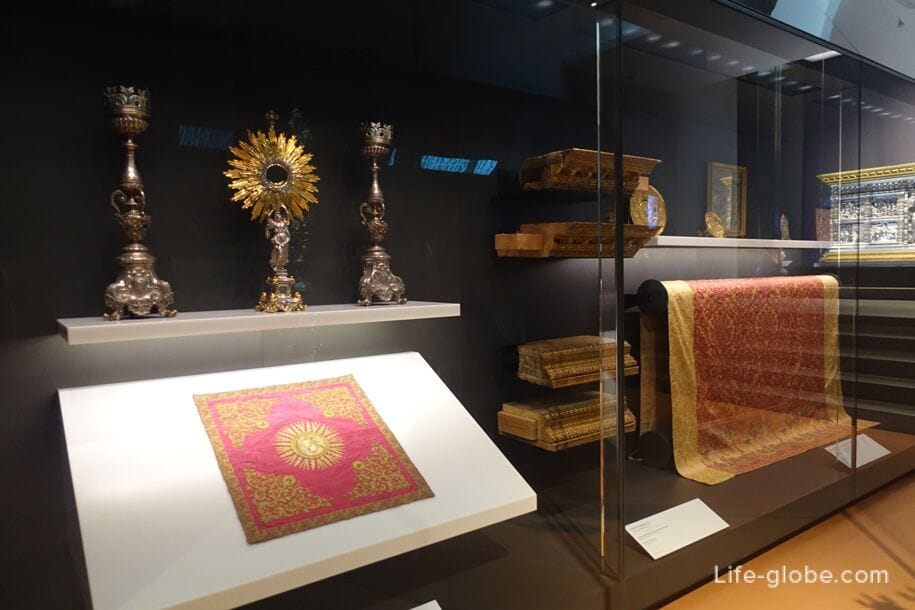
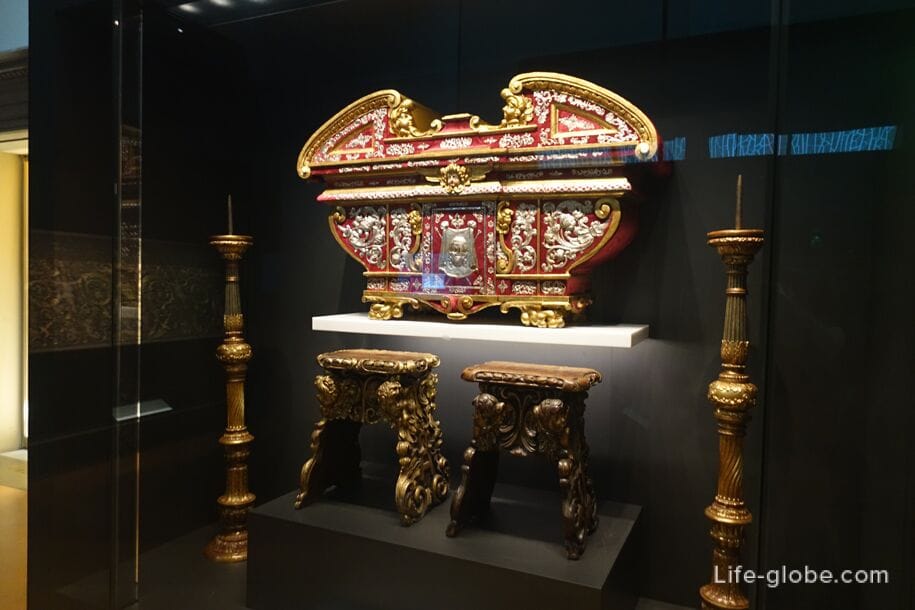
Museum of the 19th century, consisting of five rooms dedicated to the facade, built for the Duomo at the end of the nineteenth century.
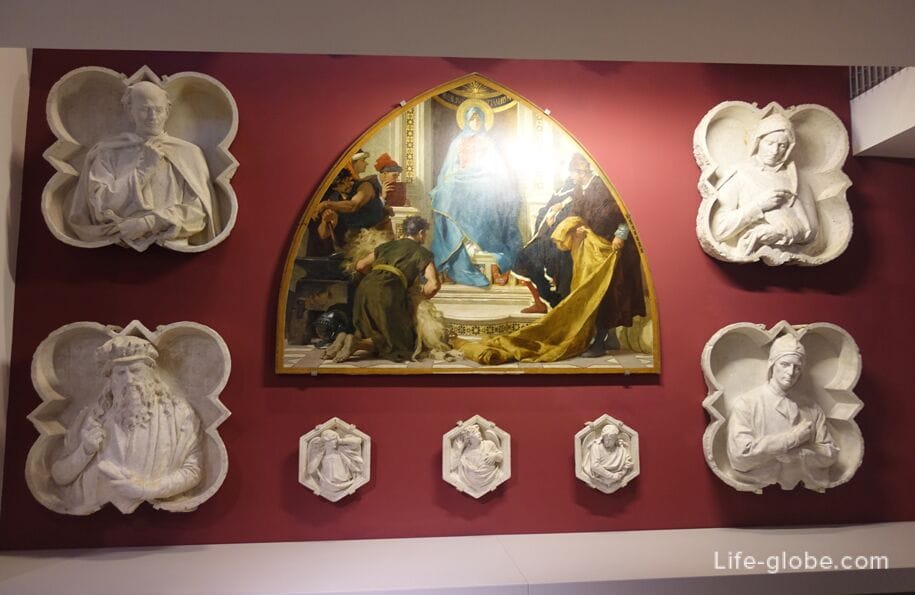
A musical chapel, where an important musical archive is kept, in which parchment choirs are distinguished, accompanied by a rich set of miniatures. Three of the most significant choral codices are alternately exhibited in this hall.
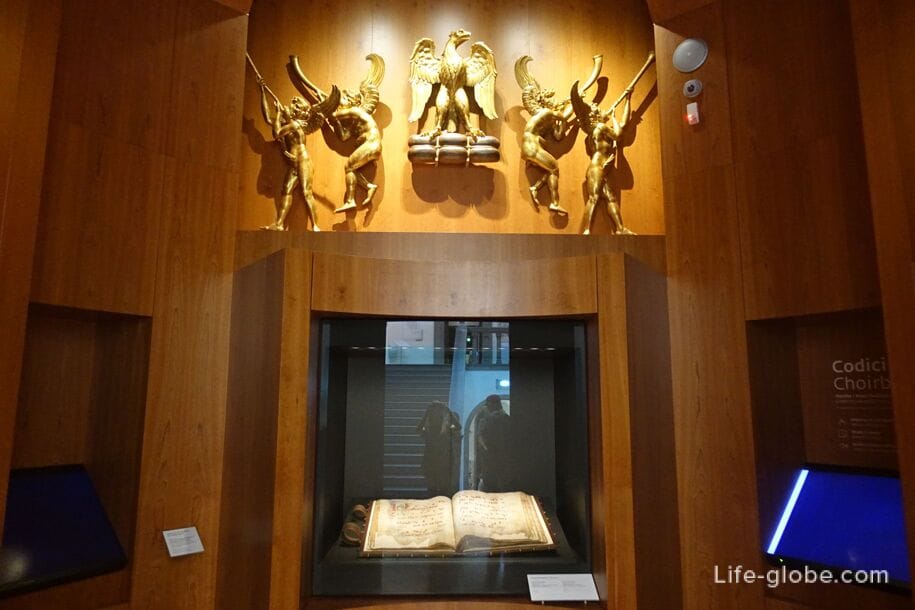
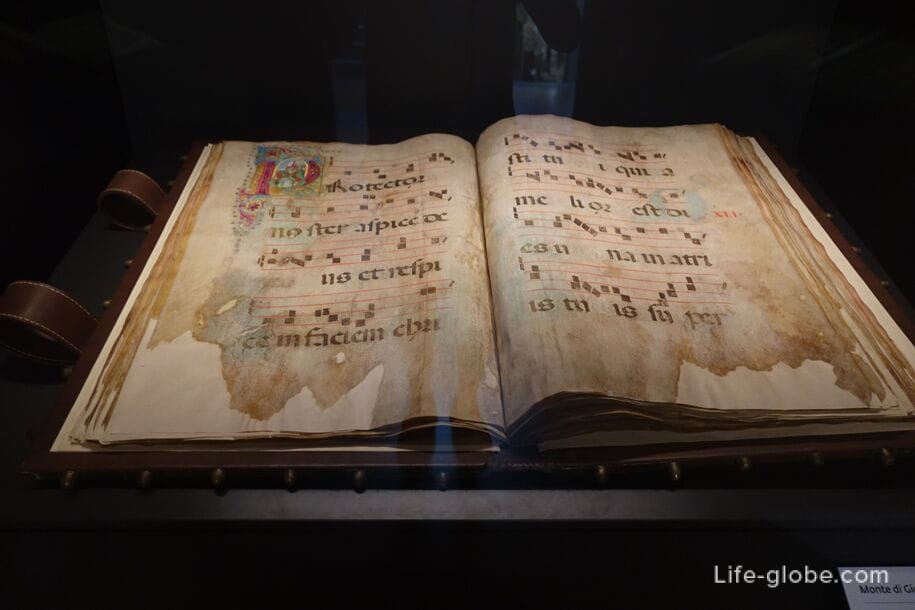
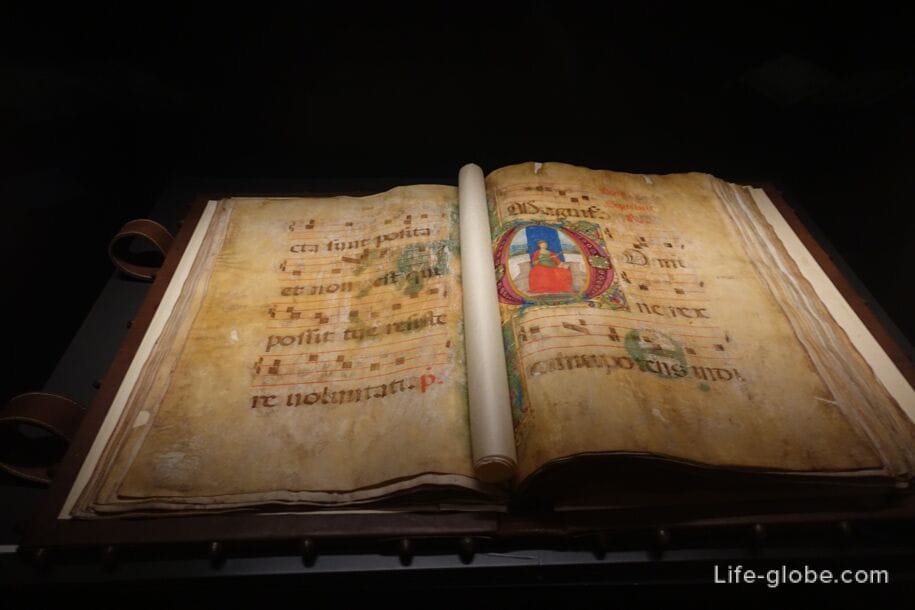
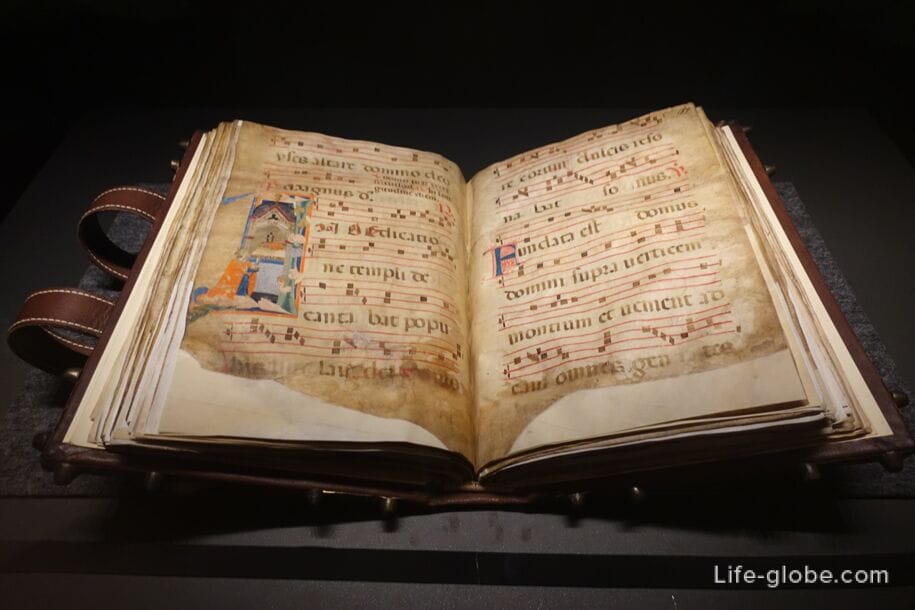
On the second floor of the Duomo Museum are located
- Model Gallery presenting projects for the modernization of the cathedral's façade, created at the behest of the Medici Grand Dukes: seven large wooden models illustrating proposals for a Renaissance façade to replace the medieval one dismantled in 1587;
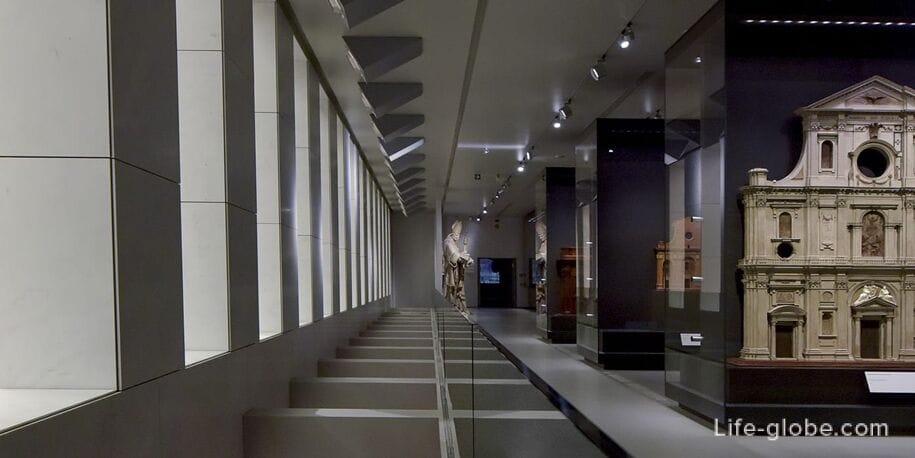
- Dome observation room, where the transparent ceiling in the mezzanine room offers an unusual view of the Brunelleschi dome;
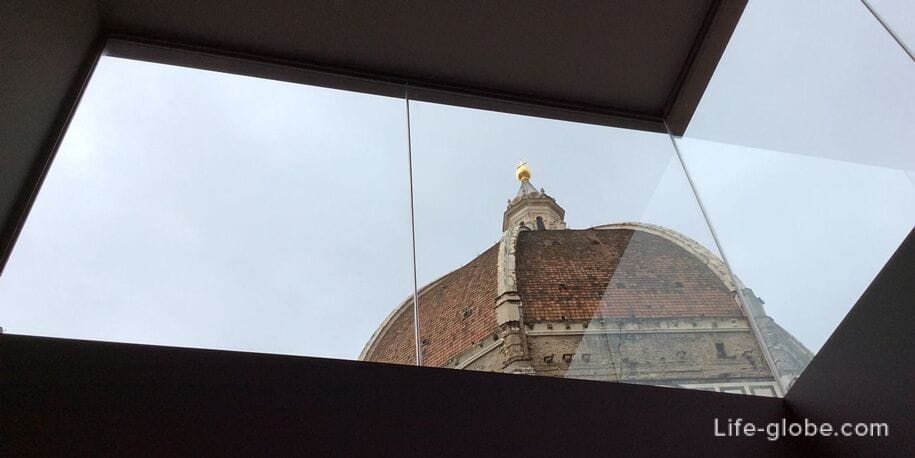
- The Medici Theater hall, where a film is shown illustrating the role of the ruling family in the history of the Duomo;
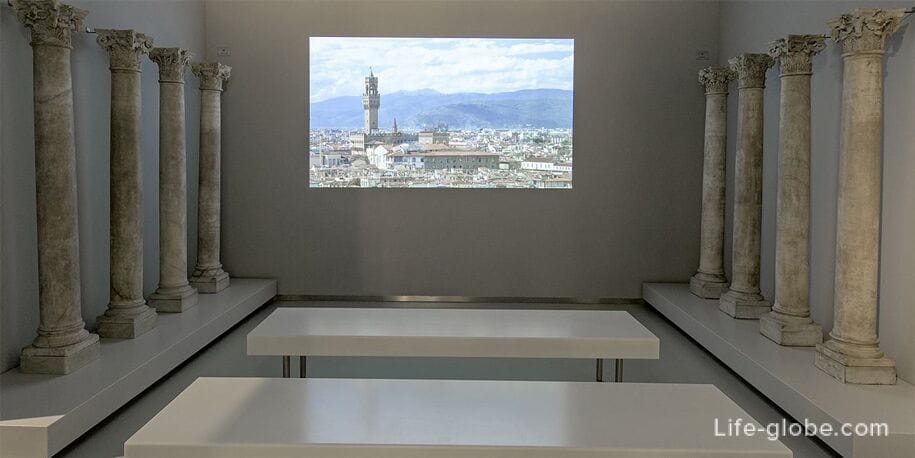
- the Hall of Vestments, in which the liturgical vestments of the 17th and 18th centuries are presented, testifying to the splendor of the liturgy in the "Cathedral of the Grand Dukes".
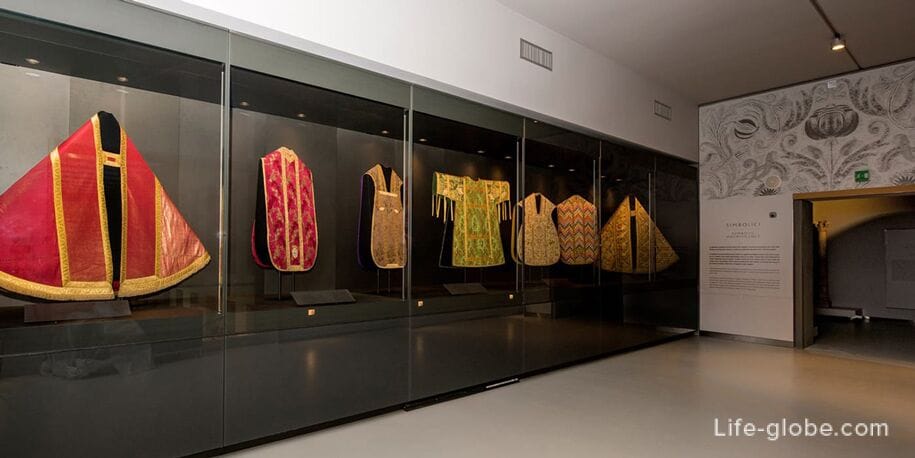
Terrace of the Duomo Museum
On the third floor of the museum there is an outdoor terrace, called the Brunelleschi Terrace, which you can access and from which you can view the cathedral and partially the Duomo Square.
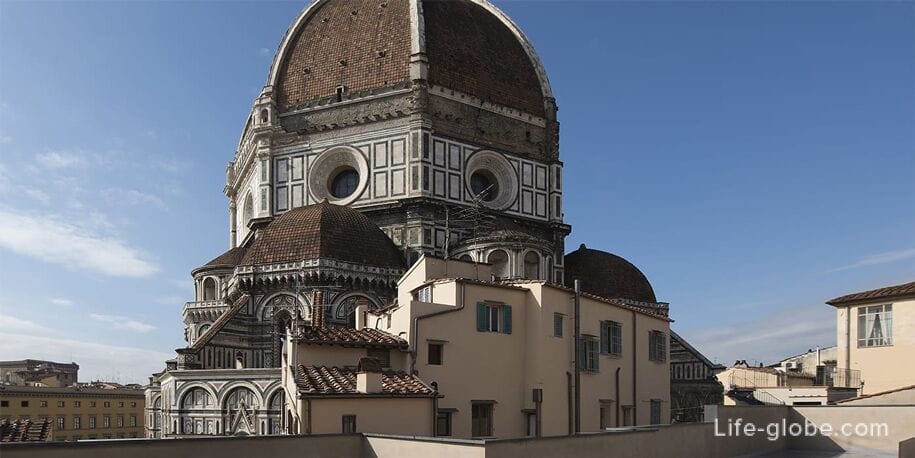
Practical information
Address of the Florence Duomo Museum: Piazza del Duomo 9, 50122, Florence.
A visit to the Duomo Museum is paid.
A visit to the museum is included in a single ticket to visit the ensemble of monuments of the Santa Maria del Fiore complex, which, in addition to the museum, also includes: the Baptistery of San Giovanni, the Brunelleschi dome with an observation deck, the Giotto bell tower with viewing platforms and the ancient Basilica of Santa Reparata under the cathedral.
There are various combinations of tickets. Tickets can be purchased online or at the ticket offices (information centers) located both in the Duomo Museum itself and on Duomo Square near the cathedral.
For more information about tickets and their cost, the opening hours of the museum and the facilities of the complex, we recommend checking on the official website of the complex: duomo.firenze.it.
All accommodation facilities in Florence (hotels, apartments, guest houses, etc.), including in the historical center of the city and more remotely from it, can be viewed and booked here






